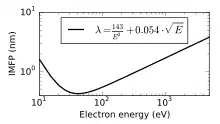Inelastic mean free path
The inelastic mean free path (IMFP) is an index of how far an electron on average travels through a solid before losing energy.

If a monochromatic primary beam of electrons is incident on a solid surface, the majority of incident electrons lose their energy because they interact strongly with matter, leading to plasmon excitation, electron-hole pair formation, and vibrational excitation.[2] The intensity of the primary electrons, , is damped as a function of the distance, d, into the solid. The intensity decay can be expressed as follows:
where is the intensity after the primary electron beam has traveled through the solid to a distance . The parameter , termed the inelastic mean free path (IMFP), is defined as the distance an electron beam can travel before its intensity decays to of its initial value. (Note that this is equation is closely related to the Beer-Lambert law.)
The inelastic mean free path of electrons can roughly be described by a universal curve that is the same for all materials.[1][3]
See also
References
- Seah, M. P.; Dench, W. A. (1979), "Quantitative electron spectroscopy of surfaces: A standard data base for electron inelastic mean free paths in solids", Surface and Interface Analysis, 1: 2–11, doi:10.1002/sia.740010103
- R. F. Egerton (1996) Electron energy-loss spectroscopy in the electron microscope (Second Edition, Plenum Press, NY) ISBN 0-306-45223-5
- Werner, Wolfgang S. M. (2001), "Review of electron transport in solids", Surface and Interface Analysis, 31 (3): 141–176, doi:10.1002/sia.973
